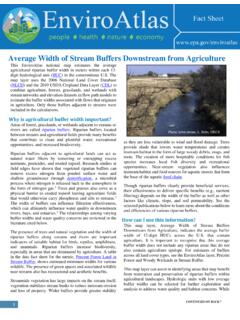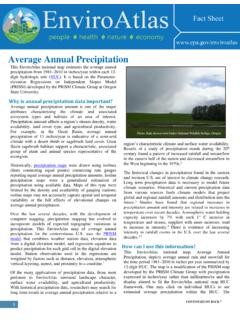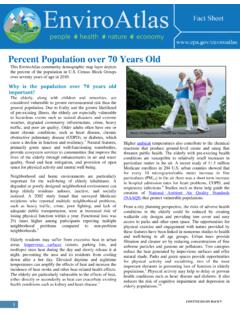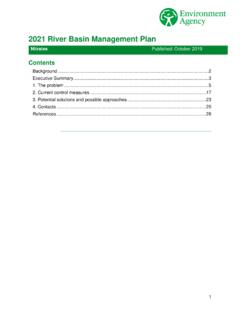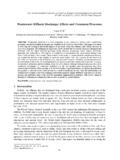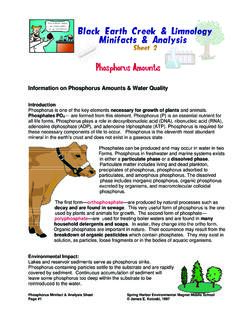Transcription of Percent Impervious Area - US EPA
1 Percent Impervious Area This EnviroAtlas national map estimates the percentage of land within each 12-digit hydrologic unit (HUC) that is classified as Impervious by the 2016 National Land Cover Dataset (NLCD) Percent Developed Imperviousness Layer. Impervious surfaces are materials that do not allow the penetration of water, such as buildings, roads, and parking lots. Why is Impervious area important? Impervious surfaces prevent rainwater from entering the soil. Pollutants from aerial and terrestrial sources accumulate on Impervious surfaces until runoff from a precipitation event carries sediment, nutrients, metals, and pesticides into stormwater drains and directly to local waterbodies. As Impervious surfaces increase, stormwater runoff increases in quantity, speed, temperature, and pollutant load. When Impervious surfaces exacerbate the effects of natural hazards, Impervious surfaces reach 10 20% of local watershed area, poor air quality, and climate change.
2 Presently, 39% of the surface runoff doubles and continues to increase until, at population lives in coastal counties on 10% of the nation's 100% Impervious surface coverage, runoff is five times that land The increase in Impervious surfaces from of a forested ,2 Excessive stormwater runoff also continued development in coastal areas and the concurrent increases the potential for flooding. decline in coastal wetlands have increased the impacts of coastal storms in recent In addition, Impervious These factors can significantly reduce water quality surfaces have been associated with increases in ambient downstream, affecting neighboring communities as well as temperatures. Impervious surfaces store heat during the day aquatic wildlife. excess nitrogen in urban runoff creates algal and slowly release it at night, preventing cooling after a hot blooms and abundant aquatic plant growth ( eutrophication ).
3 Day. In urban areas, elevated daytime and nighttime The breakdown of decomposing aquatic plants can create an temperatures from this urban heat island effect can increase oxygen deficit that negatively affects the health and heat-related health effects and the production of ground-level productivity of aquatic animal species. Sediment and ozone and smog. suspended solids reduce water clarity and light penetration, smother or retard the growth of beneficial aquatic plant life, Trees growing along roadways, in parking lots, retention and bury streambed gravel habitats essential for the basins, or riparian buffers can help mitigate the effects of sustainability of aquatic insects and fish spawning ,4 Impervious cover and benefit watersheds and communities by Poor water quality can also affect aesthetic enjoyment, slowing surface water runoff and reducing the influx of recreational opportunities, and the potential development of pollutants into local waterbodies.
4 Trees reduce air pollutants tourism or fishing. by intercepting gases and fine particulates on leaves and bark. Tree cover also helps reduce ambient temperatures through Impervious surfaces affect the quantity, as well as the quality, shading and evapotranspiration. of water resources. Normally, rainwater entering the soil recharges groundwater aquifers. Water percolates slowly How can I use this information? through the soil to enter streams and rivers, contributing to This map, Percent Impervious Area, gives a national and base flows and regulating stream flow after precipitation regional perspective of the distribution of Impervious cover. events. Excessive runoff greatly reduces rainwater percolation Users can compare this map to other national EnviroAtlas and groundwater recharge, thus contributing to potential maps such as Percent Developed Area, Percent Forest and shortages in water supply for both surface and ground Woody Wetlands in Stream Buffer, or the annual atmospheric deposition maps such as Annual Oxidized Nitrogen CONTINUED ON BACK.
5 1. Deposition. One might identify hydrologic units that may be satellite imagery. Human classification of landcover types that improved by additional tree cover to filter urban runoff, cool have a similar spectral signature can result in classification urban temperatures, or capture air pollutants. errors. As a result, NLCD is a best estimate of actual landcover. Periodic updates to EnviroAtlas will reflect By increasing the transparency of this map layer in the improvements to nationally available data. Updates may interactive map, users can view the landscape in an aerial improve accuracy as data and classification methods improve. imagery base map beneath it and overlay the Impervious areas Each version of NLCD is released several years after the date layer with select EnviroAtlas data layers, such as streams and of the satellite imagery, meaning that the land cover patterns waterbodies (NHD), wetlands (NWI), or impaired waters, to may have changed.
6 Accuracy information for the NLCD can identify possible sources of impairments and remediation be found on its website. needs. Comparison with EPA impaired waters data may assist in planning to maximize filtration capabilities when How can I access these data? implementing Total Maximum Daily Loads in streams. EnviroAtlas data can be viewed in the interactive map, Wetlands or riparian areas restored alongside or upstream of accessed through web services, or downloaded. The 2016. impaired stream segments may help reduce pollutant, NLCD Percent Developed Imperviousness Layer is available sediment, and nutrient loads to streams. Mitigation efforts at the MRLC website. may help local conditions upstream or downstream of developed areas with high concentrations of Impervious Where can I get more information? surfaces. A selection of resources on Impervious cover and water quality is listed below.
7 Information on section 303(d) of the How were the data for this map created? Clean Water Act can be found at the EPA Office of Water These data were generated by using the 2016 National Land website. For additional information on the data creation Cover Dataset (NLCD) and Esri ArcGIS Landcover process, access the metadata for the data layer from the layer classified as Impervious by the 2016 NLCD Percent list drop-down menu on the interactive map. To ask specific Developed Imperviousness Layer was used for this map. questions about these data, please contact the EnviroAtlas Landcover data were summarized by 12-digit HUC Team. boundaries from the NHDPlusV2 Watershed Boundary Dataset (WBD Snapshot). Acknowledgments EnviroAtlas is a collaborative effort by EPA, its contractors, What are the limitations of these data? and project partners. Donald Ebert and Timothy Wade, EPA, Though EnviroAtlas uses the best data available, there are developed this map for EnviroAtlas.
8 The fact sheet was limitations associated with the data. The landcover classes written by Sandra Bryce, Innovate!, Inc. found in NLCD are created through the classification of Selected Publications 1. Paul, , and Meyer. 2001. Streams in the urban landscape. Annual Reviews of Ecological Systems 32:333 365. 2. Arnold, , and Gibbons. 1996. Impervious surface coverage: the emergence of a key environmental indicator. Journal of the American Planning Association 62:243 258. 3. Aponte Clark, , Lehner, Cameron, and Frank. 1999. Stormwater strategies: Community responses to runoff pollution. Pages 179-189 in Sixth Biennial Stormwater Research & Watershed Management Conference Proceedings, September 14-17, 1999, Tampa, Florida. 4. Schueler, 2003. Impacts of Impervious cover on aquatic systems. Watershed Protection Research Monograph No. 1. Center for Watershed Protection, Ellicott City, Maryland.
9 5. National Oceanic and Atmospheric Administration (NOAA). 2013. NOAA's state of the coast. Accessed May 2020. 6. Costanza, R. O. Perez-Maqueo, Martinez, P. Sutton, Anderson, and K. Mulder. 2008. The value of coastal wetlands for hurricane protection. Ambio 37(4):241 248. EnviroAtlas: Led by the Environmental Protection Agency July 2020.

